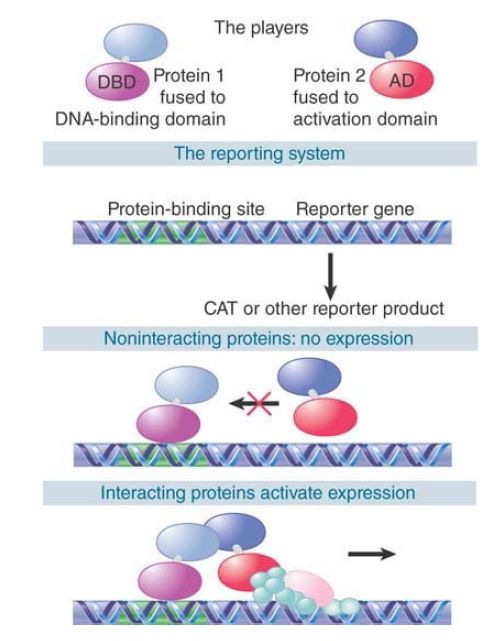


 النبات
النبات
 الحيوان
الحيوان
 الأحياء المجهرية
الأحياء المجهرية
 علم الأمراض
علم الأمراض
 التقانة الإحيائية
التقانة الإحيائية
 التقنية الحيوية المكروبية
التقنية الحيوية المكروبية
 التقنية الحياتية النانوية
التقنية الحياتية النانوية
 علم الأجنة
علم الأجنة
 الأحياء الجزيئي
الأحياء الجزيئي
 علم وظائف الأعضاء
علم وظائف الأعضاء
 الغدد
الغدد
 المضادات الحيوية
المضادات الحيوية|
Read More
Date: 24-5-2021
Date: 16-4-2021
Date: 7-6-2021
|
The Two-Hybrid Assay Detects Protein–Protein Interactions
Key concept
- The two-hybrid assay works by requiring an interaction between two proteins, where one has a DNA-binding domain and the other has a transcription-activation domain.
The model of domain independence is the basis for an extremely useful assay for detecting protein interactions. The principle is illustrated in FIGURE 1. One of the proteins to be tested is fused to a DNA-binding domain. The other protein is then fused to a transcription-activating domain. This is accomplished by linking the appropriate coding sequences in each case and making chimeric proteins by expressing each hybrid gene.

FIGURE 1. The two-hybrid technique tests the ability of two proteins to interact by incorporating them into hybrid proteins,where one has a DNA-binding domain and the other has a transcription-activating domain.
If the two proteins that are being tested can interact with one another, the two hybrid proteins will interact. This is reflected in the name of the technique: the two-hybrid assay. The protein with the DNA-binding domain binds to a reporter gene that has a simple promoter containing its target site. It cannot, however, activate the gene by itself. Activation occurs only if the second hybrid binds to the first hybrid to bring the activation domain to the promoter. Any reporter gene can be used where the product is readily assayed, and this technique has given rise to several automated procedures for rapidly testing protein–protein interactions.
The effectiveness of the technique dramatically illustrates the modular nature of proteins. Even when fused to another protein, the DNA-binding domain can bind to DNA, and the transcriptionactivating domain can activate transcription. Correspondingly, the interaction ability of the two proteins being tested is not inhibited by the attachment of the DNA-binding or transcription-activating domains. (Of course, there are some exceptions for which these simple rules do not apply, and interference between the domains of the hybrid protein prevents the technique from working.)
The power of this assay is that it requires only that the two proteins being tested can interact with each other. They need not have anything to do with transcription (in fact, if the proteins being tested themselves are involved in transcription, it can frequently lead to false positives, as a single hybrid may work as an activator). As a result of the independence of the DNA-binding and transcriptionactivating domains, all that is required is that they are brought together. This will happen so long as the two proteins being tested can interact in the environment of the nucleus.



|
|
|
|
دراسة تكشف "مفاجأة" غير سارة تتعلق ببدائل السكر
|
|
|
|
|
|
|
أدوات لا تتركها أبدًا في سيارتك خلال الصيف!
|
|
|
|
|
|
|
مجمع العفاف النسوي: مهرجان تيجان العفاف يعزز القيم الأخلاقية والثقافية لدى طالبات الجامعات العراقية
|
|
|